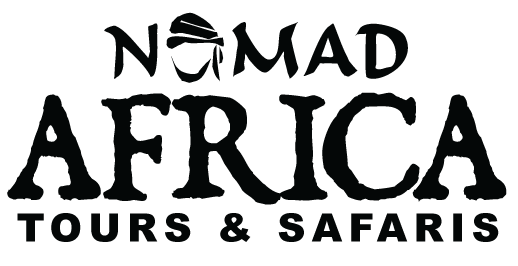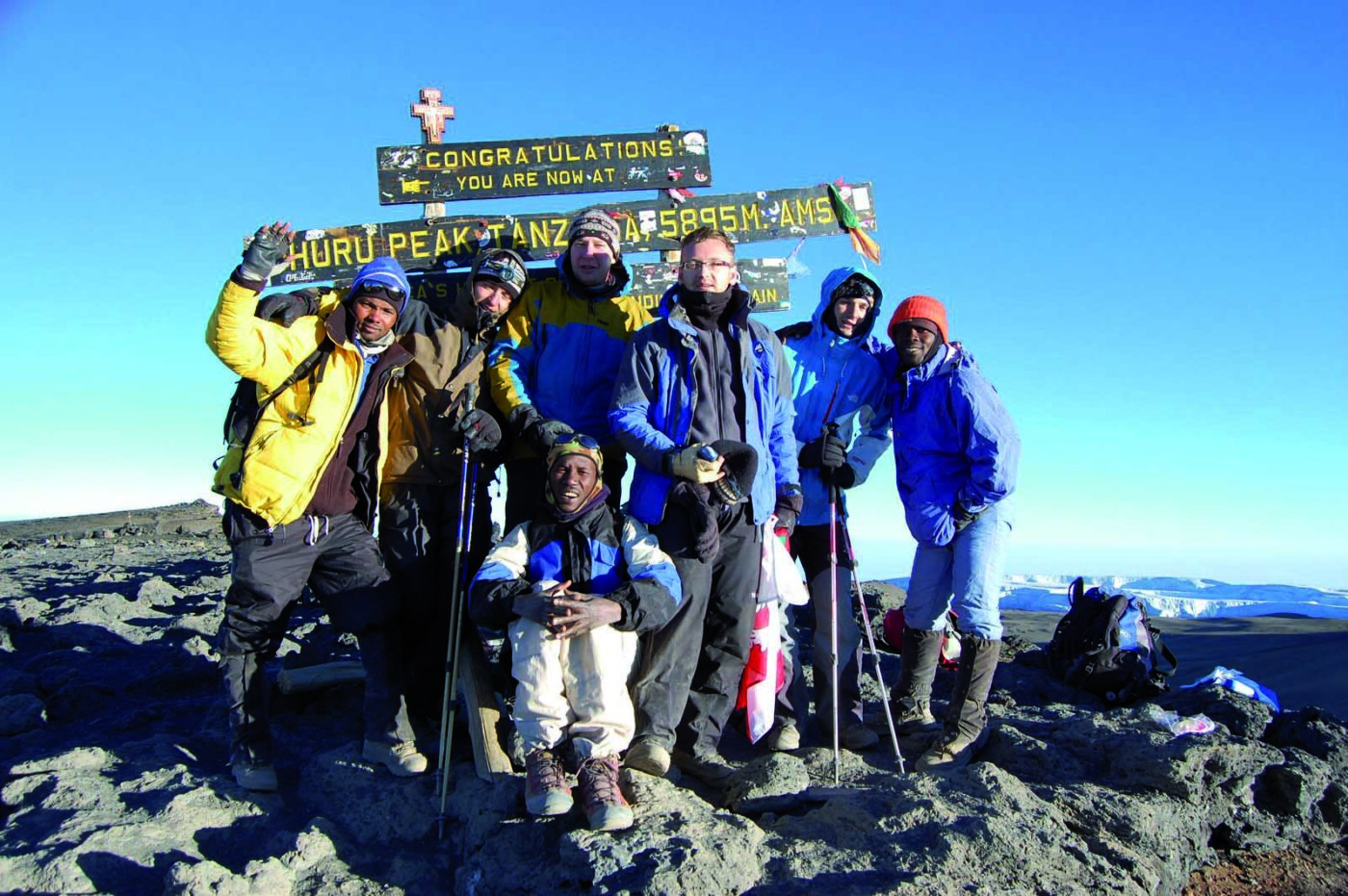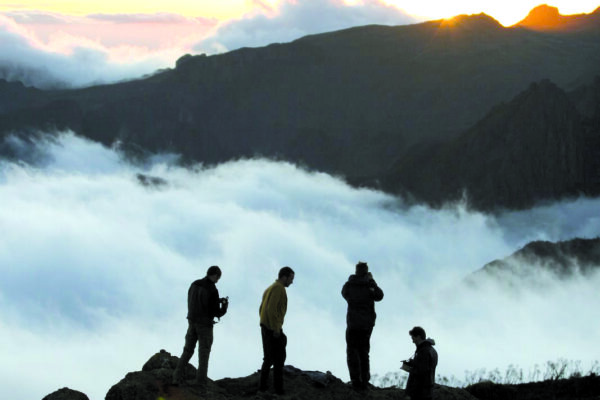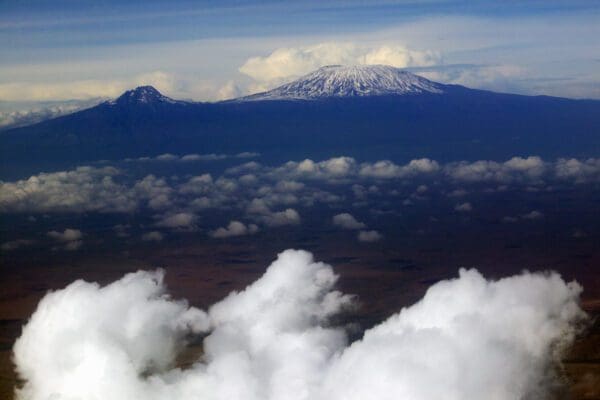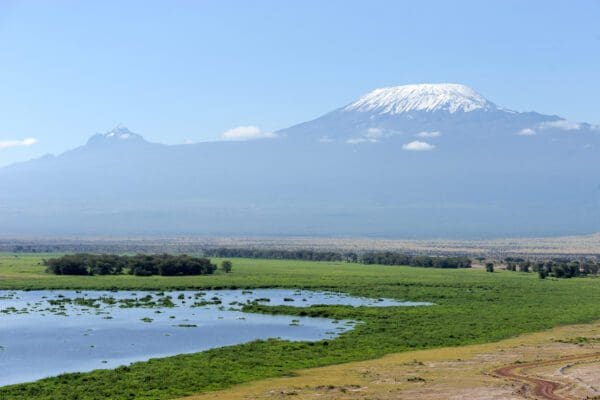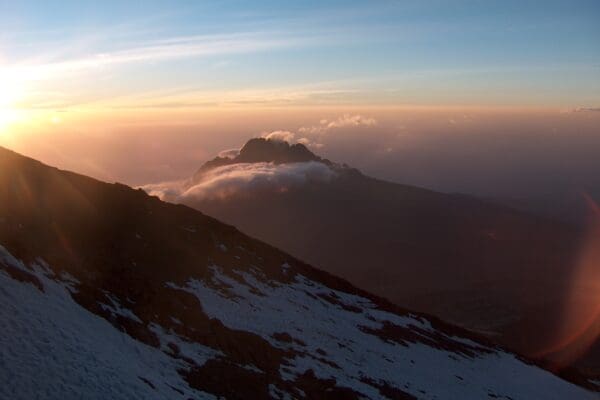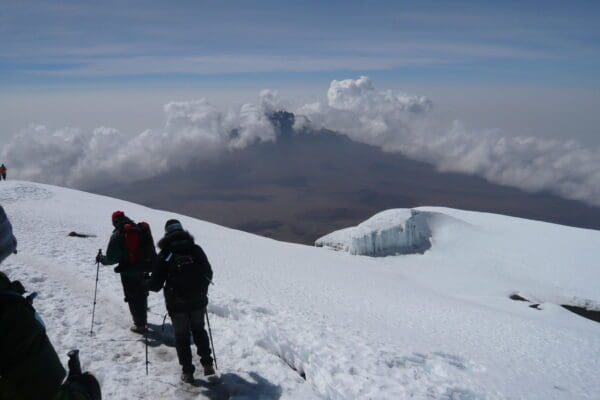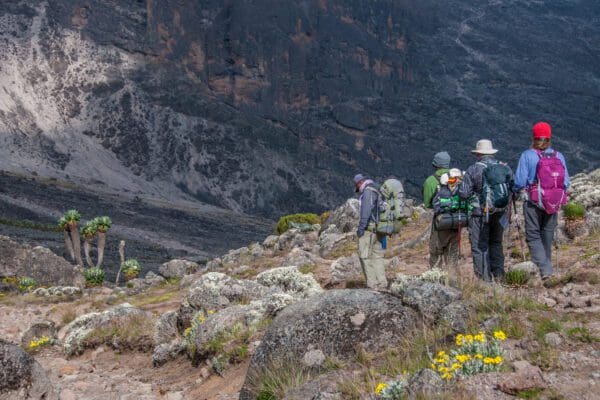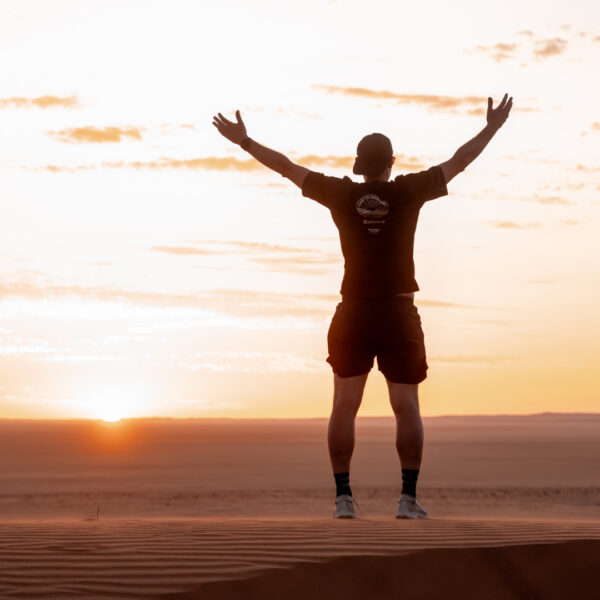Embark on an unforgettable 8-day Kilimanjaro trek via the Machame Route, journeying from lush rainforest to alpine desert before summiting Africa’s highest peak, Uhuru. Experience breathtaking scenery, expert guidance, and rewarding challenges as you ascend through diverse landscapes, culminating in a sunrise celebration on the “Roof of Africa.”
Kilimanjaro – Machame Route
GUIDED
USD 2,330
PER PERSON SHARING
USD 70
COMPULSORY SINGLE SUPPLEMENT
What's Included?
- Professional, English-speaking Guide
- Mountain crew (cook & porters)
- 7 nights‘ stay in lodges and mountain tents (depending on availability)
- Camping equipment (tents, sleeping mats, chairs, tables etc)
- Meals according to the itinerary
- Drinking water
- All national park fees
- All mentioned transfers
The Machame route
Located on the mountain’s southern side, Machame is known for its steep sections and longer daily treks. Although it is more challenging than the previous two routes, it is popular due to its incredible views of Kilimanjaro’s three peaks. Having reached the summit, the descent follows the Mweka Route.
Our Premium Journeys are designed for travelers who want comfort, character, and connection woven seamlessly into their African adventure. Staying in carefully selected 3–5 star lodges and boutique camps, you’ll enjoy en-suite rooms, hearty meals, and welcoming hospitality at the end of each day. With shorter travel days, more time is spent where it matters most—immersed in the landscapes, wildlife, and culture that make each destination unforgettable. Whether it’s a sunset boat cruise on a quiet river, a glass of wine by the fire, or waking up to birdsong in the bush, our itineraries are crafted to maximize unhurried, meaningful moments. Travel in smaller groups for a more personal experience, with expert guides who bring every story and sight to life. Premium Journeys strike the perfect balance of comfort and adventure, leaving you free to focus on the joy of discovery.
Guided travel involves hiring a professional guide who serves as a local guide and driver, and takes care of the driving responsibilities. The traveler can focus on enjoying the trip and the destination without the stress of driving. The driver-guide provides local knowledge, expertise, and recommendations, and can offer a more immersive and personalized experience. It can be more expensive than self-drive travel but provides convenience, safety, and local insights.
Your Kilimanjaro adventure begins in Arusha, where you’ll settle in at Meru View Lodge and meet your guide for a pre-trek briefing. The next morning, the climb starts at Machame Gate, ascending through lush rainforest alive with colobus monkeys and moss-draped trees before reaching Machame Camp. The trail continues to New Shira Camp, where expansive views of the mountain open up across heath and moorland. Onward to Lava Tower, the altitude challenges your endurance while revealing stark alpine landscapes before descending into the scenic Barranco Valley. A steep scramble up Barranco Wall rewards you with sweeping glacier views, followed by a steady climb to Barafu Camp, your base for summit day. In the early hours, you’ll tackle the final ascent to Uhuru Peak — the “Roof of Africa” — and watch sunrise over the continent from 5,895m. The descent follows through Mweka Camp and rainforest trails to Mweka Gate, where your achievement is celebrated before returning to Arusha for a well-earned rest and hot shower. The journey concludes with your transfer back to Kilimanjaro Airport, marking the end of an unforgettable 8-day expedition.
Kilimanjaro FAQs
Before every trek, the Trekking Operations Manager gives you an extensive briefing regarding the route, safety procedures, and health issues. You will have an opportunity to ask any questions that you have. Next, he will inspect the quality of your trekking gear to ensure your safety and comfort on the mountain. If you need any additional equipment, you can rent it from us.
During the trek, you carry a small backpack with essentials such as water for the day’s hike. Porters will carry all the equipment, food, and additional luggage to set up the camp before you arrive. They are tough climbers and the true heroes of the mountain. The mountain guides will lead the way and are responsible for your safety. They have trekked Kilimanjaro hundreds of times and receive regular training. They will encourage you throughout the trek. They continually assess the weather and the condition of the trekkers. When extreme weather or altitude sickness or injury occurs, they will call the climb off if necessary.
Cooks are miracle workers. With simple gas cookers, they conjure up 3-course feasts, hot drinks, and snacks to nourish you when you need it most. The mountain crew fetches drinking water from mountain streams and boils it before you drink it. Porters pitch and take down the two-person tents you use. This leaves you to concentrate on getting to the top. All camping gear is inspected and cleaned regularly.
On day one, following breakfast, you will be driven to the entrance of Kilimanjaro National Park, where your guide will take care of the registration forms and park fees. Soon after, you will begin trekking through a lush forest to reach your first campsite five to six hours later. Here, you will enjoy a delicious evening meal as you wind down to spend your first night on this captivating mountain. Each subsequent day starts with a hearty breakfast to fuel up on energy for the big climb ahead. Shortly afterwards, you start trekking. You will stop midway to rest and enjoy lunch with a view before continuing onwards and upwards to the next campsite.
For the next two to three days, you continue this routine of climbing the mountain for five to seven hours per day. During summit night, you’ll set off at midnight. Ahead of you is a five to six-hour final ascent so that you can arrive in time to witness dawn breaking on top of Africa’s highest mountain.
Having taken in the breathtaking sunrise and summit views, you will descend the mountain for another five to six hours of trekking. This will be the longest day on the mountain but likely the most memorable. On the final day, you’ll enjoy your last mountain breakfast, followed by a traditional farewell ceremony where you can thank your mountain team. After the final descent, we will drive you to your lodge to relax and celebrate your achievements.
The best time to climb Mount Kilimanjaro is during the dry season, from July to October. This period offers the best weather conditions and minimises the risk of cloud cover obstructing the view. However, it is essential to note that the weather can change quickly, and one may experience four seasons in a day. Temperatures drop significantly in the evenings and mornings, and frosts are common, so packing warm clothes is essential. Tanzania experiences two rainy seasons, namely the long rains from late March to mid-May and the short rains, which occur less predictably between November and December.
The peak season for climbing the mountain is from July to October, and it can get quite busy. However, the shoulder seasons, which occur from the end of May to the end of June and from December to mid-May, are also great options with good weather and fewer trekkers on the mountain. Moreover, the shoulder season is a great time to combine a trek with a safari. It is worth noting that trekking the mountain may not be possible due to unsafe weather conditions in April, May, and November.
Reaching the summit of Mount Kilimanjaro does not require technical climbing skills, but it remains a challenging feat that requires good health and physical fitness. You should be able to trek for five to seven hours daily. You should also have enough reserve to hike for twelve to fourteen hours on the summit ascent and descent day. Having the determination and fortitude to make it to the top is also essential. Altitude sickness may be an issue for some, but adding an extra acclimatisation day to your itinerary will improve your chances of success.
Self-drive travel refers to a type of travel where the traveler rents a vehicle and drives themselves, taking full responsibility for navigating, driving, and managing the trip. It allows for greater independence, flexibility, and control over the itinerary, pace, and stops along the way. Self-drive travel can offer a sense of adventure and freedom, but also requires good driving skills and knowledge of local traffic laws and regulations.
On the other hand, driver-guided travel involves hiring a professional driver who serves as a local guide and takes care of the driving responsibilities. The traveler can focus on enjoying the trip and the destination without the stress of driving. The driver-guide provides local knowledge, expertise, and recommendations, and can offer a more immersive and personalized experience. It can be more expensive than self-drive travel but provides convenience, safety, and local insights.
After booking your trek, we will send you the pre-departure information to assist you in planning your Mount Kilimanjaro trek. The comprehensive packing list is one of the most crucial resources.
Tipping the mountain crew: The team of mountain guides is exceptional, and they will play a significant role in helping you to reach the summit. Additionally, you’ll be impressed by the hard work and dedication of the porters, cooks, and waiters, who go above and beyond to ensure you have the best possible experience on your trek. It is customary to tip the mountain crews. If you think they did a good job and you would like to thank them with a tip, it will be gratefully received. We will provide instructions on how much to tip, how to do it, and when.
Children below 10 can only hike up to Shira Camp but no further. Since children are more susceptible to altitude sickness than adults, we suggest a minimum age limit of 14-16 years of age, and a parent should accompany them.
There are no age limits for older trekkers, but it is recommended that those over 60 should undergo a comprehensive medical check-up before attempting to climb the mountain.
The mountain rescue services in Tanzania are less advanced than those in Europe. If an accident occurs, the injured person will be transported on a wheeled stretcher off the mountain, as helicopters cannot land at higher altitudes. It is crucial to obtain comprehensive travel insurance that includes rescue and repatriation coverage.
Available Departures
Price From
Price From
Price From
Price From
Price From
Price From
Price From
Price From
Price From
Price From
Journey Itinerary
Upon your arrival at Kilimanjaro Airport, you will be welcomed by your transfer driver and taken to the Meru View Lodge in Usa River on the outskirts of Arusha. The rest of the day will be at leisure and you can either relax at the lodge or explore the town of Arusha (taxi required). In the evening you will attend a briefing in preparation of the upcoming trek. Dinner and overnight at.
After breakfast you will be picked up at your hotel and taken to the entrance gate of the Kilimanjaro National Park. While your guide is busy with the registration forms, you can watch the mountain team prepare for the climb and once this is all done, your Kilimanjaro adventure will begin. In no time you will be deep within the magnificent mountain rainforest with ancient trees, primeval ferns, liana, lichen and moss that carpets the ground and drapes from the trees. You will hear and with a little luck even spot the beautiful black and white colobus monkeys in the treetops. After 5 to 6 hours, you will reach today’s destination: the Machame Camp which is situated just above the tree line. Here, at the base of Mount Kilimanjaro, you will have your first dinner followed by an overnight stay in tents.
After an early morning start, the path steepens. The landscape changes into heath and moorland and the open landscape allows you to see the impressive mountain range. Today’s stage is shorter than the previous day and you will arrive at the New Shira Camp by mid-afternoon. The camp has a breath-taking view of the mountain and during sunset, the evening sun lights the rock face and glacier of Kibo.
Today you will climb about 800 metres, but you will be camping at an elevation only slightly higher than the previous night. This will allow your body to acclimatise as a height of over 4500 metres will be reached over the next two days. The trek begins with a long ascent above the Shira Plateau in the direction of the Lava Tower. The vegetation becomes sparser as the landscape changes to an afro-alpine desert. The route passes through the sweeping Barranco Valley with its lobelia and giant senecio plants. After 6 to 7 hours, you will arrive at the most beautiful camp on the mountain: the Barranco Camp.
After a cup of hot tea and a light snack, the climb begins at midnight. By torchlight, you will climb the screes of Kibo. After 5 to 7 hours of ascending in the dark you will arrive at Stella Point (5730m), the crater rim of Mount Kilimanjaro. Another 1 to 2 hours climb along the crater ridge will lead you to Uhuru Peak. Here you will see Kilimanjaro in all its glory, enjoying the 360 degree view over the landscape below as the sun rises. You are now standing on the “Roof of Africa”. The simple descent runs almost along the same route and shortly before midday, you should arrive at Barafu Camp where the porters and the cook will be waiting for you. After a warm meal and a well-deserved break of approximately 1 to 2 hours, you will be on your way down to Mweka Camp where supper and a well-earned rest await you.
The final leg of your amazing adventure begins after breakfast with a traditional farewell ceremony from the mountain crew. Then a gentle 2 to 3 hours descent through the rainforest continues to Mweka Gate, where your driver will be waiting for you. He will take you back to the lodge in Arusha and after a hot shower, the rest of the day is free to rest, relax at the pool or celebrate your achievement.
Today is your departure day, after breakfast, you will be transferred to Kilimanjaro Airport.
– Luggage and sleeping bag
– Waterproof travel bag, trekking rucksack, or kit bag and rain cover max. 12 kg (26 lbs)
– Day pack with rain cover
– Sleeping bag (temperature rating of -12 °C)
You will only need to carry the daily essentials in a day pack; your porter will carry any further luggage. All your equipment must be packed in a travel bag, trekking rucksack or a kit bag and not exceed 12 kg (26 lbs). The porters cannot carry bags with roll systems or suitcases. Please also take note of the luggage regulations of your airline.
Clothing
– Trekking pants
– T-shirts
– Rain jacket and rain pants (e.g. Gore-Tex or similar)
– Rain poncho
– Warm fleece, thermal or softshell jacket
– Fleece jersey
– Sports or functional underwear
– Long- or short-sleeved functional shirts
– Long leggings or thermal pants
– Warm gloves, mittens
– Thin gloves as liner glove and sun protection
– Ski pants (for the summit night)
– Winter jacket (for the summit night)
– High and water-proof hiking boots (well broken in)
– Sneakers to wear around camp
– Gaiters (as protection against rubble and dampness)
– Trekking socks
– Warm beanie or balaclava
– Scarf or bandana
– Sun hat or cap
You need the right equipment and clothing to climb Kilimanjaro. While it can be hot at the park gate, depending on the season, temperatures can go down to -10 °C and lower at the summit. We recommend wearing multiple layers, so you can add or remove items depending on your personal preference and changing climatic conditions.
Other items
– Sunglasses with UV protection
– Trekking poles
– Water bottles
– Headlamp (preferably LED) and spare batteries
– Toiletry bag
– Towel
– Toilet paper, ca. 1 roll/person
– Sunscreen with high sun protection factor, also as lip protection
– Muesli or granola bars, energy bars, nuts or chocolate, dextrose, vitamin and mineral tablets to dissolve in water
– Emergency whistle
– Earplugs
– Photo equipment, spare batteries, adapter for charger (charging only possible at hotel)
– Watch, phone with alarm, adapter for charger (charging only possible at hotel)
– Mobile charger (power bank) (to charge devices on the mountain)
– Card game, book, or similar
– Malaria prophylaxis (after consultation with your doctor or tropical institute)
– First-aid kit
Items carried by the crew:
– Finger pulse oximeter
– First-aid kit
Items NOT carried by the crew:
– Inflatable pressure bag/Gamow Bag
– Stethoscope
You can store luggage which you do not need on the mountain at your hotel. You can rent equipment if you cannot bring it yourself. We will send you a separate overview, including prices. Important: In Tanzania, all plastic bags are banned. You are not allowed to carry plastic bags with you. You are allowed to bring small “ziploc bags” to carry your toiletries, as long as you do not dispose of them while in Tanzania. Any “ziploc bags” must be taken home with you on departure.
- All services except those listed
- Inbound Flights, Airport taxes
- Visas
- Porterage
- Tips and gratuities
- Anything of personal nature
If you require accommodation before or after your journey we can arrange this for you. We can also arrange airport transfers – contact your travel agent or Nomad to make these bookings.
Nomad has a non-profit Trust that looks after the people, animals and places that we visit. We realise that a footprint is left where we travel and for this reason, the Nomad Africa Trust was established. Your donation to the Trust is called a “Green Seat”. If you would like to help Nomad making Africa Greener, simply choose the tick box during your booking process (or contact us afterwards to add it) and we will take care of the rest. The Nomad African Trust is responsible for the administration of the funds collected from the sale of the green seats and these funds are distributed to various projects as identified by the Trust.
